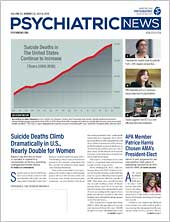The mental health field continues to experience a significant service gap. Despite an increase in demand for psychiatric services, access to care continues to lag. In this context, telepsychiatry, defined as the use of information and communication technologies to provide mental health services remotely via videoconferencing, has emerged as a method to enhance access to care. A large body of evidence supports the use of telepsychiatry as an effective, acceptable, and cost-efficient method of health care delivery that is equivalent to face-to face care.
Despite being used since the 1950s, telepsychiatry’s expansion has historically faced significant obstacles to large-scale implementation. These included numerous limited connectivity, security and technology issues, licensure restrictions, reimbursement challenges, and limited clinical training. However, the past few years have witnessed significant advances in these areas, particularly with regard to licensure, reimbursement, and educational resources available to psychiatrists, leading to significant growth in telepsychiatry adoption.
Licensure Restrictions
Licensure regulations require that a psychiatrist be licensed in the state where the patient is located at the time services are provided. Except for those practicing in the U.S. Army and Department of Veterans Affairs, licensure has created a significant administrative and time-consuming burden for physicians wishing to practice in multiple states. While some osteopathic and medical boards have started offering specific telehealth licensure, the adoption of the Interstate Medical Licensure Compact (IMLC) by 22 states in 2017 constituted a breakthrough.
IMLC offers expedited licensure for physicians wishing to practice in more than one state, when certain criteria are met. These include having an unrestricted medical license in another IMLC state, board certification, absence of a criminal history, and absence of disciplinary actions, among other criteria (see http://www.imlcc.org/do-i-qualify/). The IMLC is a significant step closer to licensure reciprocity, overcoming a major barrier to telepsychiatry expansion.
Reimbursement
Medicare reimburses telehealth services only when the patient is located at a site in a rural Health Professional Shortage Area or outside of a Metropolitan Statistical Area. However, Medicare reimbursement ensures parity for telepsychiatry and in-person care. While significant variations remain at the state level, the public programs of 48 states and the District of Columbia now reimburse for telehealth services, to some degree. Rhode Island and Massachusetts are the exceptions. Finally, it is important to note that despite the above restrictions and variations, Medicare, Medicaid, and third-party insurance have taken steps toward expanding reimbursement for telepsychiatry services.
Training and Resources
Telepsychiatry training during residency has been somewhat limited, despite high interest from residents and despite data that correlate telepsychiatry training with increased adoption. There has been a gradual shift toward incorporating telehealth into the education and training of residents and medical students to enhance comfort and expertise with using videoconferencing for care delivery. Meanwhile, many resources have become available to psychiatrists looking to incorporate telepsychiatry into their practices. APA offers a valuable resource on its website, including the
Telepsychiatry Toolkit.
Conclusion
The advances in reimbursement, licensure, and education for telepsychiatry are steps in the right direction. Further advancement will require advocacy work to enhance telepsychiatry reimbursement, legislative changes to further expand the IMLC, and restructuring of psychiatry training programs. As the barriers hindering the expansion of telepsychiatry are overcome, this method of mental health care delivery will continue to develop. ■

